I'm not sure if it meet your demand. The code create an image with top and bottom shadow, and all rounding corner, you can modify the code to achieve what you need. You can use the image as the background of your cell(It's seems that it is UITableViewCell)
Let me know if it don't work for you.
The image:
// create a shadow image
CGSize size = CGSizeMake(ScreenWidth, ScreenWidth);
UIGraphicsBeginImageContextWithOptions(size, NO, 0);
CGContextRef context = UIGraphicsGetCurrentContext();
UIColor *backgroundColor = [UIColor colorWithRed:246.0/255.0 green:246.0/255.0 blue:246.0/255.0 alpha:1.0];
UIColor *fillColor = [UIColor whiteColor];
CGRect rect = CGRectMake(10, 10, 100, 44);
// re-draw the background
CGContextSetFillColorWithColor(context, backgroundColor.CGColor);
CGContextFillRect(context, CGRectMake(0, 0, size.width, size.height));
// set top and bottom shadow
CGRect rectTop = CGRectMake(rect.origin.x, rect.origin.y, rect.size.width, 5);
CGContextSaveGState(context);
CGContextSetShadowWithColor(context, CGSizeMake(0, -5), 5, [UIColor colorWithRed:0 green:0 blue:0 alpha:0.1].CGColor);
CGContextSetFillColorWithColor(context, [UIColor redColor].CGColor);
CGContextFillRect(context, rectTop);
CGContextRestoreGState(context);
CGRect rectBottom = CGRectMake(rect.origin.x, rect.origin.y+rect.size.height-5, rect.size.width, 5);
CGContextSaveGState(context);
CGContextSetShadowWithColor(context, CGSizeMake(0, 5), 5, [UIColor colorWithRed:0 green:0 blue:0 alpha:0.1].CGColor);
CGContextSetFillColorWithColor(context, [UIColor redColor].CGColor);
CGContextFillRect(context, rectBottom);
CGContextRestoreGState(context);
// re-draw the background
CGContextSetFillColorWithColor(context, backgroundColor.CGColor);
CGContextFillRect(context, rect);
CGContextSaveGState(context);
UIBezierPath *maskPath = [UIBezierPath bezierPathWithRoundedRect:rect byRoundingCorners:UIRectCornerAllCorners cornerRadii:CGSizeMake(4.0, 4.0)];
[maskPath addClip];
CGContextSetFillColorWithColor(context, fillColor.CGColor);
CGContextFillRect(context, rect);
CGContextRestoreGState(context);
You can modify the code to get a top left shadow:
// create a shadow image
CGSize size = CGSizeMake(ScreenWidth, ScreenWidth);
UIGraphicsBeginImageContextWithOptions(size, NO, 0);
CGContextRef context = UIGraphicsGetCurrentContext();
UIColor *backgroundColor = [UIColor colorWithRed:246.0/255.0 green:246.0/255.0 blue:246.0/255.0 alpha:1.0];
UIColor *fillColor = [UIColor whiteColor];
CGRect rect = CGRectMake(10, 10, 100, 44);
// re-draw the background
CGContextSetFillColorWithColor(context, backgroundColor.CGColor);
CGContextFillRect(context, CGRectMake(0, 0, size.width, size.height));
// set top and left shadow
CGRect rectTop = CGRectMake(rect.origin.x, rect.origin.y, rect.size.width, 5);
CGContextSaveGState(context);
CGContextSetShadowWithColor(context, CGSizeMake(0, -5), 5, [UIColor colorWithRed:0 green:0 blue:0 alpha:0.1].CGColor);
CGContextSetFillColorWithColor(context, [UIColor redColor].CGColor);
CGContextFillRect(context, rectTop);
CGContextRestoreGState(context);
CGRect rectLeft = CGRectMake(rect.origin.x, rect.origin.y, 5, rect.size.height);
CGContextSaveGState(context);
CGContextSetShadowWithColor(context, CGSizeMake(-5, 0), 5, [UIColor colorWithRed:0 green:0 blue:0 alpha:0.1].CGColor);
CGContextSetFillColorWithColor(context, [UIColor redColor].CGColor);
CGContextFillRect(context, rectLeft);
CGContextRestoreGState(context);
// re-draw the background
CGContextSetFillColorWithColor(context, backgroundColor.CGColor);
CGContextFillRect(context, rect);
CGContextSaveGState(context);
UIBezierPath *maskPath = [UIBezierPath bezierPathWithRoundedRect:rect byRoundingCorners:UIRectCornerAllCorners cornerRadii:CGSizeMake(4.0, 4.0)];
[maskPath addClip];
CGContextSetFillColorWithColor(context, fillColor.CGColor);
CGContextFillRect(context, rect);
CGContextRestoreGState(context);
HTH
